Paul Gauguin
Paintings
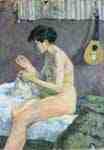
Study of a Nude (Suzanne sewing)
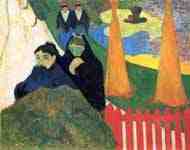
Old Virgins pass through a garden
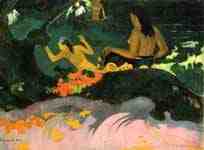
Seaside ( Fatata te miti )
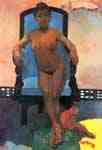
Annah the Javanese
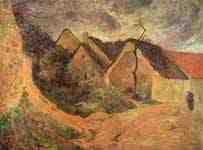
Rising way in Osny
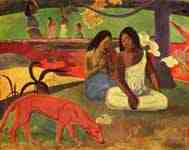
Arearea
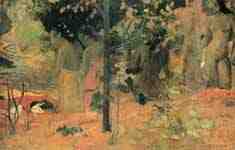
Bathers
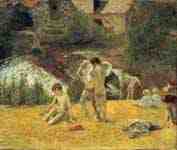
Bathers at the mill of Bois d' Amour , Pont-Aven
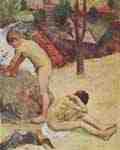
Bathins Breton boys
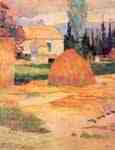
Farmhouse in Arles
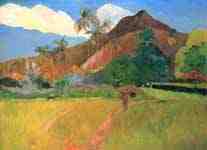
Mountains in Tahiti
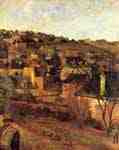
Blue roofs at Rouen
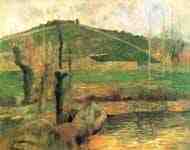
View of Sainte-Marguerite
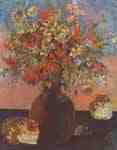
Flowers and Cats
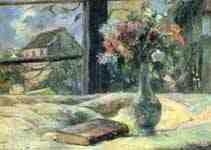
Flower vase at the window
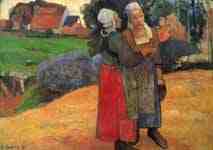
Breton peasant women
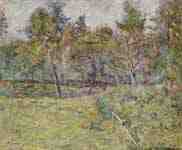
Breton Landscape
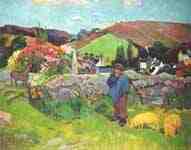
Breton Landscape With Swineherd
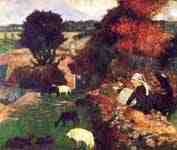
Breton shepherdess
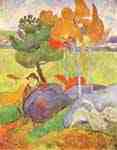
Breton gooseherd
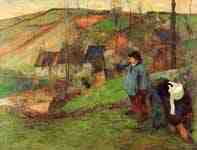
Breton Shepherd
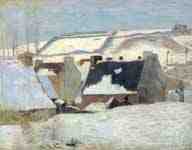
Breton Village in the Snow
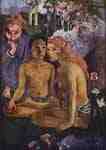
Contes barbares (Exotic Sagas)
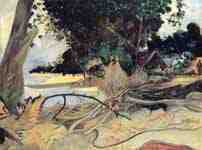
The thick Tree (Te burao)
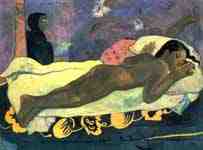
The spirit of the dead wakes ( Manao Tupapau )
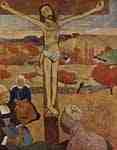
The Yellow Christ
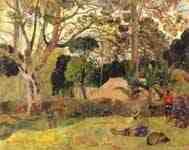
The Green Christ
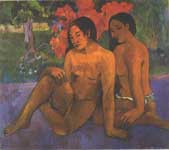
And the gold of their bodys
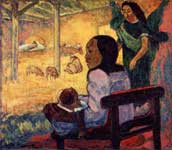
Bébé (Birth)
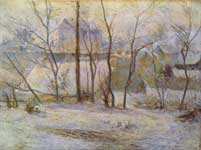
Effect of snow
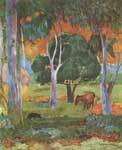
Hiva Oa

Landscape with a Horse
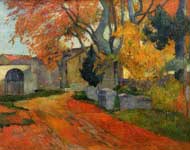
Lane at Alchamps, Arles
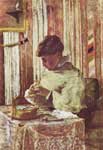
Mette Gauguin
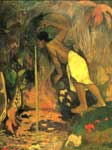
Mysterious Water (Pape moe )
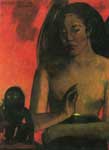
Savage Poems
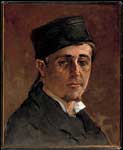
Self portrait
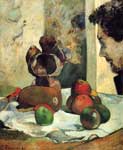
Still Life with Profile of Laval

Tahitian Woman and Boy
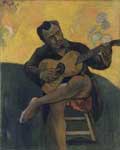
The Guitar Player
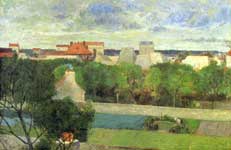
The Market Gardens of Vaugirard
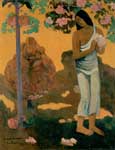
The Month of Mary
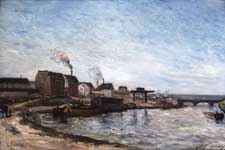
The Seine at Pont de Grenelle
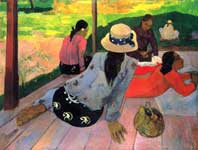
The Violoncellist Schneklud
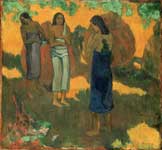
Three Tahitian Women Against a Yellow Background
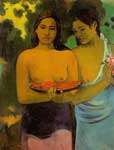
Two Tahitian Women
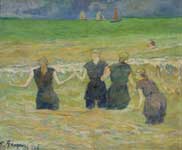
Women Bathing
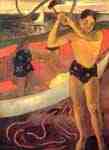
The man with the ax
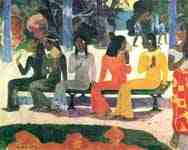
The Market ( Ta matete )

The Moon and the Earth ( Hina Tefatou )
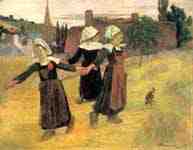
The dance of the little Breton Women
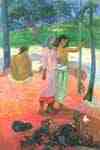
The reputation

The white horse
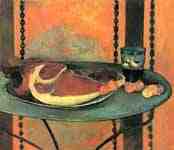
The ham
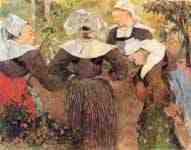
The Dance of the Four Breton Women
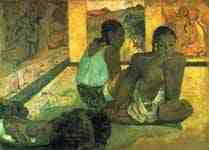
The Dream (Te rerioa )
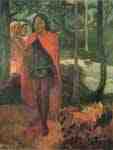
The Wizard of Hiva-Oa
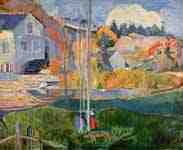
The David - mill in Pont -Aven

The woman with the flower
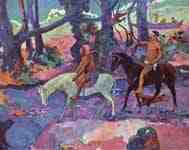
The ford
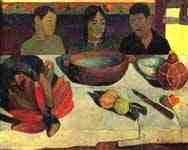
The Meal ( Still life with bananas)
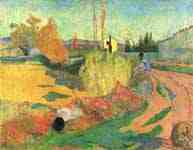
The Mas of Arles
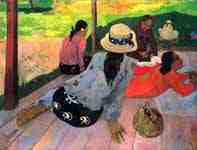
The siesta
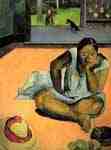
The Pouting (Te Faaturuma )
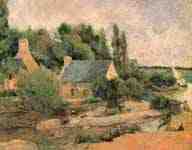
The washerwomen of Pont- Aven
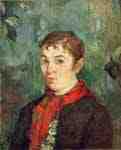
The innkeeper's daughter
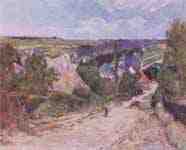
Entrance to the village
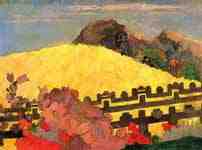
There is the temple ( Parahi te marae )
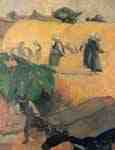
Harvest in Brittany

Faa Iheihe
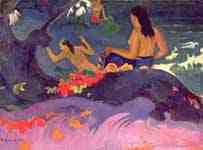
Fatata Te Miti
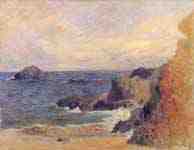
Rocky sea coast
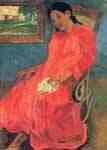
Woman in red dress
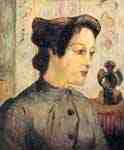
Woman with Hair Bun
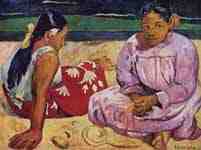
Women on the beach
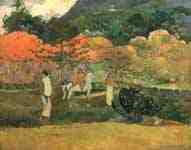
Women and white horse
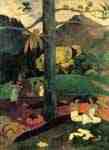
Previously ( Mata mua )
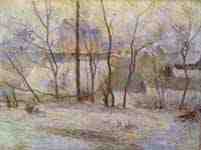
Garden in the Snow
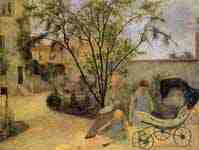
Garden in the Rue Carcel
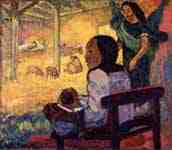
Birth ( Bé Bé )
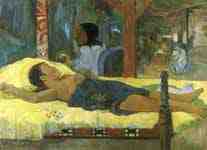
Nativity
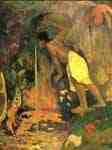
Mysterious source ? ( Pape moe )
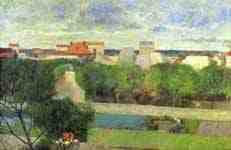
Vegetable farmers in Vauguirard
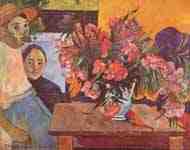
Large Bouquet with Tahitian children
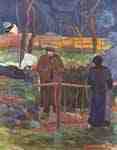
Good morning Mr. Gauguin
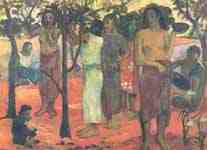
Wonderful days ( Nave nature mahana )
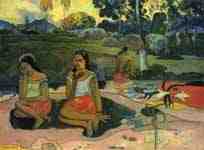
Gorgeous secret ( Nave nature moe )
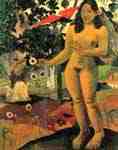
Gorgeous Country (Te nature nature fenua )
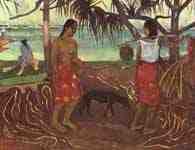
I Raro Te Oviri
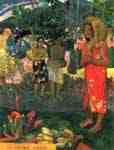
Ia Orana Maria ( Hail Mary)
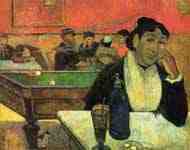
In the cafe ( portrait of Mme Ginoux )
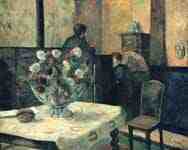
Interior of the painter in the Rue Carcel
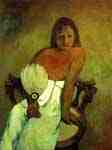
Young Girl with a Fan
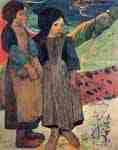
Breton girls at Sea
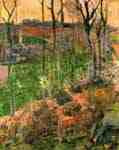
Young Breton, the wooden shoe adjusting
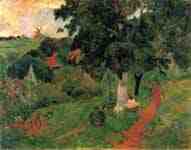
Coming and Going
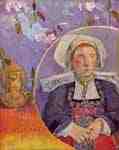
La belle Angèle
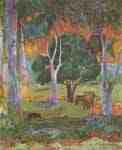
Landscape on La Dominique ( Hiva Oa )
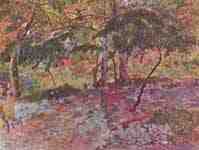
Landscape in Martinique

Landscape in Tahiti
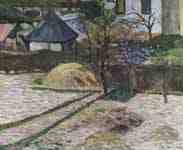
Landscape at Osny
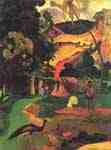
Landscape with peacocks ( Matamoe )
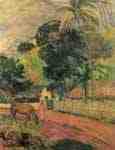
Landscape ( horse on the way )
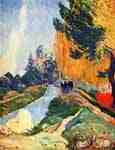
Les Alyscamps
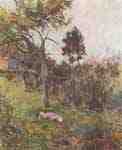
Woman lying in the landscape
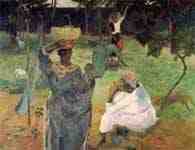
Mangoes
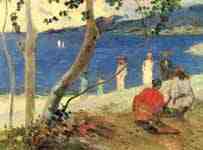
Seashore
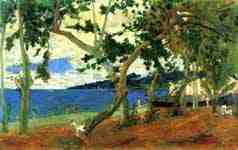
Seashore
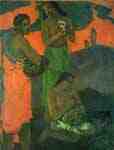
Maternity
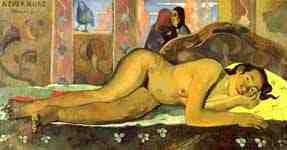
Nevermore
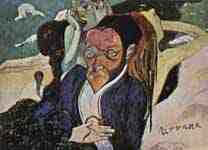
Nirvana , Portrait of Meyer de Haan
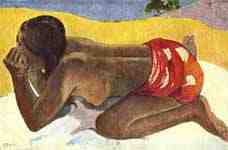
Otahi alone
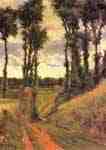
Poplars
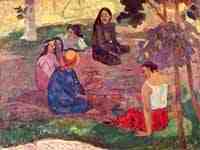
Parau Parau ( gossip )
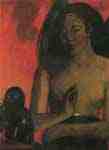
Poèmes barbares
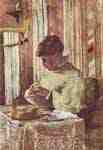
Portrait of Madame Gauguin
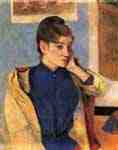
Portrait of Madeleine Bernard
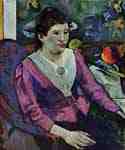
Portrait of Marie Derrien Lagadu
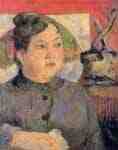
Portrait of Mme Alexandre Kohler
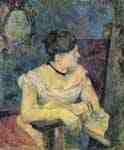
Portrait of Mme Gauguin in evening dress
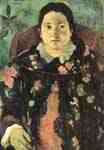
Portrait of Suzanne Bambridge
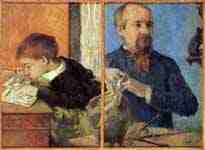
Portrait of the sculptor Aubé with his son
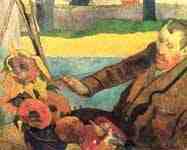
Portrait of Vincent van Gogh, painting Sunflowers
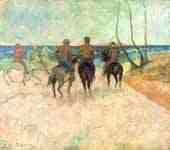
Riders on the beach
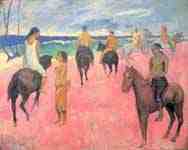
Riders on the beach
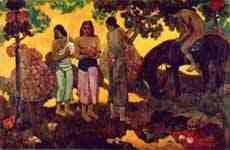
Rupe Rupe ( Fruit harvest)
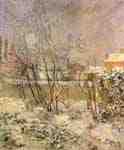
Snow in the Rue Carcel
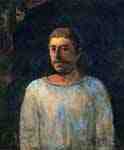
Self-portrait » près du Golgotha "
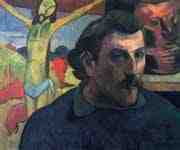
Self-Portrait with Yellow Christ
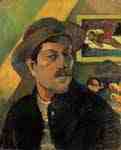
Self-portrait
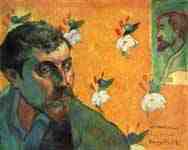
Self-Portrait " Les Misérables "
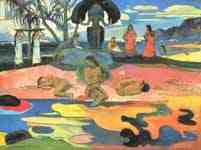
Sunday ( Mahana no atua )
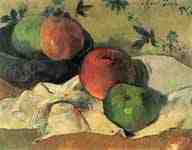
Still life » à l' ami Jacob "
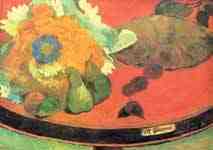
Still life » à la fête Gloanec "
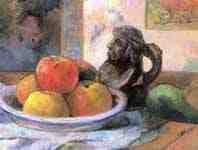
Still life with apples , pear and jug
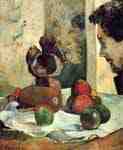
Still Life with Profile of Charles Laval
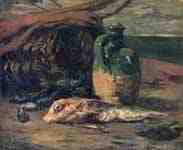
Still Life with Fish
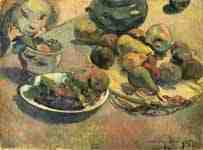
Still Life with Fruit
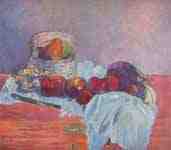
Still life with fruits , basket and knife
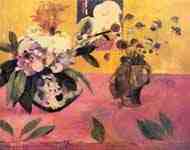
Still life with Japanese woodcut
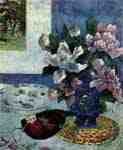
Still Life with Mandolin
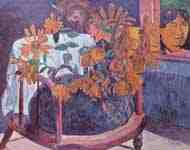
Still life with sunflowers
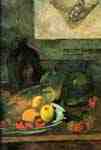
Still life in front of an engraving by Delacroix

Self-Portrait with Halo

Tahitian woman with Mango
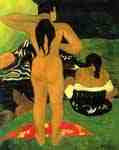
Tahitian women on the beach
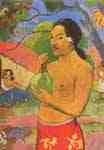
Tahitian woman with fruit , detail
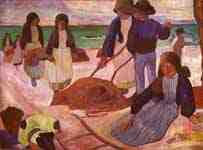
Seaweed Collector
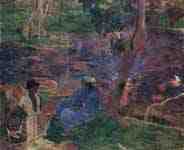
Pond shore
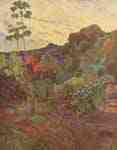
Tropical flora
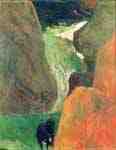
About the abyss
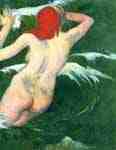
Undine
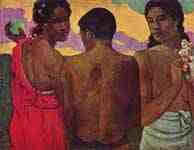
Entertainment in Tahiti
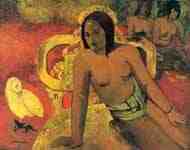
Vairumati
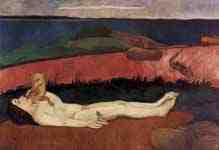
Loss of virginity
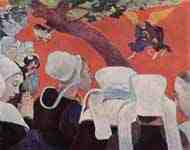
Vision after the Sermon
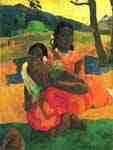
When are you getting married? ( Nafea faa ipoipo ? )
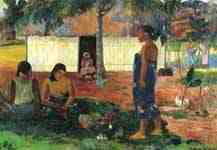
Why are you angry ? ( No te aha oe riri ? )
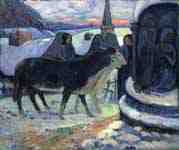
Christmas
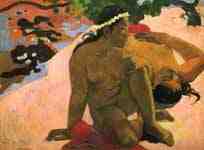
What ? Are you jealous ? ( Aha oe feii ? )
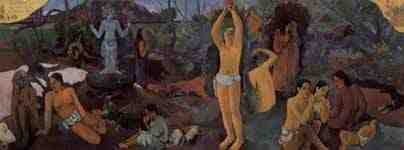
Where did we come from? Who are we? Where are we going ?
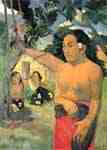
Where are you going ? ( E haere oe i hia ? )
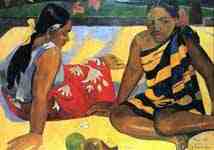
Two Women of Tahiti
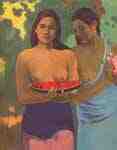
Two girls with mango blossoms
Drawings
Bathing Breton Boy
Breton peasants with cattle and dog
The " Arlesienne "
Crouching girl from Tahiti
Head of a Breton
Head of a peasant girl
Girl with fox
Washerwomen in Arles
Illustrations
Manao Tupapau
Portrait of Stéphane Mallarmé
Te arii vahine
Drinking fisherman next to his boat
Eugène Henri Paul Gauguin (French pronunciation: [ɡoɡɛ̃]; 7 June 1848 – 8 May 1903) was a leading French Post-Impressionist artist, painter, sculptor, printmaker, ceramist and writer. His bold experimentation with colouring led directly to the Synthetist style of modern art while his expression of the inherent meaning of the subjects in his paintings, under the influence of the cloisonnist style, paved the way to Primitivism and the return to the pastoral. He was also an influential proponent of wood engraving and woodcuts as art forms.[1][2]
Biography
Paul Gauguin was born in Paris, France to journalist Clovis Gauguin and Aline Maria Chazal, daughter of the half-Peruvian proto-socialist leader Flora Tristan, a feminist precursor. In 1851 the family left Paris for Peru, motivated by the political climate of the period. Clovis died on the voyage, leaving three-year old Paul, his mother and sister to fend for themselves. They lived for four years in Lima, Peru with Paul's uncle and his family. The imagery of Peru would later influence Paul in his art.
At the age of seven, Paul and his family returned to France. They moved to Orléans, France to live with his grandfather. He soon learned French and excelled in his studies. At seventeen, Gauguin signed on as a pilot's assistant in the merchant marine to fulfill his required military service. Three years later, he joined the French navy where he stayed for two years. In 1871, Gauguin returned to Paris where he secured a job as a stockbroker. In 1873, he married a Danish woman, Mette-Sophie Gad. Over the next ten years, they had five children.
By 1884 Gauguin had moved with his family to Copenhagen, where he pursued a business career as a stockbroker. Driven to paint full-time, he returned to Paris in 1885, leaving his family in Denmark. Without adequate subsistence, his wife (Mette Sophie Gadd) and their five children returned to her family. Gauguin outlived two of his children. Like his friend Vincent van Gogh, with whom in 1888 he spent nine weeks painting in Arles, Paul Gauguin experienced bouts of depression and at one time attempted suicide. In 1891, Gauguin, frustrated by lack of recognition at home and financially destitute, sailed to the tropics to escape European civilization and "everything that is artificial and conventional". (Before this he had made several attempts to find a tropical paradise where he could 'live on fish and fruit' and paint in his increasingly primitive style, including short stays in Martinique and as a labourer on the Panama Canal construction; however, he was dismissed from his job after only two weeks.)
In 1903, due to a problem with the church and the government, he was sentenced to three months in prison and fined. At that time he was being supported by the art dealer Ambroise Vollard[3] He died of syphilis before he could start the prison sentence. His body had been weakened by alcohol and a dissipated life. He was 54 years old.
Gauguin died on 8 May 1903 and is buried in Calvary Cemetery (Cimetière Calvaire), Atuona, Hiva ‘Oa, Marquesas Islands, French Polynesia.
Artistic career
Gauguin began painting in his free time. He also visited galleries frequently and purchased work by emerging artists. Gauguin formed a friendship with artist Camille Pissarro, who introduced him to various other artists. As he progressed in his art, Gauguin rented a studio, and showed paintings in Impressionist exhibitions held in 1881 and 1882. Over two summer holidays, he painted with Camille Pissarro and occasionally Paul Cézanne.
Where Do We Come From? What Are We? Where Are We Going?1897 Boston Museum of Fine Arts, Boston, MA, USA
In 1887, after visiting Panama, he spent several months near Saint Pierre in Martinique, in the company of his friend the artist Charles Laval. At first, the 'negro hut' in which they lived suited him and he enjoyed watching people in their daily activities.[4] However, the weather in the summer was hot and the hut leaked in the rain. He also suffered dysentery and marsh fever. While in Martinique, he produced between ten and twenty works (twelve being the most common estimate) and traveled widely and apparently came into contact with a small community of Indian immigrants, a contact that would later influence his art through the incorporation of Indian symbols. Gauguin, along with Emile Bernard, Charles Laval, Emile Schuffenecker and many others frequently visited the artist colony of Pont-Aven in Brittany. By the bold use of pure color and Symbolist choice of subject matter the group is now considered a Pont-Aven School. Disappointed with Impressionism, he felt that traditional European painting had become too imitative and lacked symbolic depth. By contrast, the art of Africa and Asia seemed to him full of mystic symbolism and vigour. There was a vogue in Europe at the time for the art of other cultures, especially that of Japan (Japonism). He was invited to participate in the 1889 exhibition organized by Les XX.
Cloisonnism and Synthetism
Under the influence of folk art and Japanese prints, Gauguin evolved towards Cloisonnism, a style given its name by the critic Édouard Dujardin in response to Émile Bernard's method of painting with flat areas of color and bold outlines, which reminded Dujardin of the Medieval cloisonné enamelling technique. Gauguin was very appreciative of Bernard's art and of his daring with the employment of a style which suited Gauguin in his quest to express the essence of the objects in his art.[5]
In The Yellow Christ (1889), often cited as a quintessential Cloisonnist work, the image was reduced to areas of pure colour separated by heavy black outlines. In such works Gauguin paid little attention to classical perspective and boldly eliminated subtle gradations of colour, thereby dispensing with the two most characteristic principles of post-Renaissance painting. His painting later evolved towards Synthetism in which neither form nor colour predominate but each has an equal role.
Paul Gauguin, Te aa no areois (The Seed of the Areoi), 1892, The Museum of Modern Art
Living in Mataiea Village in Tahiti, he painted "Fatata te Miti" ("By the Sea"), "Ia Orana Maria" (Ave Maria) and other depictions of Tahitian life. He moved to Punaauia in 1897, where he created the masterpiece painting "Where Do We Come From" and then lived the rest of his life in the Marquesas Islands, returning to France only once, when he painted at Pont-Aven.
His works of that period are full of quasi-religious symbolism and an exoticized view of the inhabitants of Polynesia. In Polynesia, he sided with the native peoples, clashing often with the colonial authorities and with the Catholic Church. During this period he also wrote the book Avant et après (before and after), a fragmented collection of observations about life in Polynesia, memories from his life and comments on literature and paintings.
Historical significance
The Spirit of the Dead Keep Watch, 1892, Albright-Knox Art Gallery, Buffalo, NY
Primitivism was an art movement of late 19th century painting and sculpture; characterized by exaggerated body proportions, animal totems, geometric designs and stark contrasts. The first artist to systematically use these effects and achieve broad public success was Paul Gauguin. The European cultural elite discovering the art of Africa, Micronesia, and Native Americans for the first time were fascinated, intrigued and educated by the newness, wildness and the stark power embodied in the art of those faraway places. Like Pablo Picasso in the early days of the 20th century, Gauguin was inspired and motivated by the raw power and simplicity of the so-called Primitive art of those foreign cultures.
Gauguin is also considered a Post-Impressionist painter. His bold, colorful and design oriented paintings significantly influenced Modern art. Gauguin's influence on artists and movements in the early 20th century include Vincent van Gogh, Henri Matisse, Pablo Picasso, Georges Braque, André Derain, Fauvism, Cubism and Orphism, among others. Later he influenced Arthur Frank Mathews and the American Arts and Crafts Movement.
John Rewald, an art historian focused on the birth of Modern art, wrote a series of books about the Post-Impressionist period, including Post-Impressionism: From Van Gogh to Gauguin (1956) and an essay, Paul Gauguin: Letters to Ambroise Vollard and André Fontainas (included in Rewald's Studies in Post-Impressionism, 1986), discusses Gauguin's years in Tahiti, and the struggles of his survival as seen through correspondence with the art dealer Vollard and others.
Gauguin and Van Gogh
Gauguin's relationship with Van Gogh was rocky. Gauguin had shown an early interest in Impressionism, and the two shared bouts of depression and suicidal tendencies. In 1888, Gauguin and Van Gogh spent nine weeks together, painting in the latter's Yellow House in Arles. During this time, Gauguin became increasingly disillusioned with Impressionism, and the two quarreled. On the evening of December 23, 1888, frustrated and ill, Van Gogh confronted Gauguin with a razor blade. In a panic, Van Gogh fled to a local brothel. While there, he cut off the lower part of his left ear lobe. He wrapped the severed tissue in newspaper and handed it to a prostitute named Rachel, asking her to "keep this object carefully."[6] Gauguin left Arles and never saw Van Gogh again.[7] A few days later, Van Gogh was hospitalized.
Legacy
The vogue for Gauguin's work started soon after his death. Many of his later paintings were acquired by the Russian collector Sergei Shchukin. A substantial part of his collection is displayed in the Pushkin Museum and the Hermitage. Gauguin paintings are rarely offered for sale; their price may be as high as $39.2 million US dollars.
Gauguin's posthumous retrospective exhibitions at the Salon d'Automne in Paris in 1903 and an even larger one in 1906 had a stunning and powerful influence on the French avant-garde and in particular Pablo Picasso's paintings. In the autumn of 1906, Picasso made paintings of oversized nude women, and monumental sculptural figures that recalled the work of Paul Gauguin and showed his interest in primitive art. Picasso's paintings of massive figures from 1906 were directly influenced by Gauguin's sculpture, painting and his writing as well. The power evoked by Gauguin's work lead directly to Les Demoiselles d'Avignon in 1907.[8]
According to Gauguin biographer David Sweetman, Picasso as early as 1902 became an aficionado of Gauguin's work when he met and befriended the expatriate Spanish sculptor and ceramist Paco Durrio (1875–1940), in Paris. Durrio had several of Gauguin's works on hand because he was a friend of Gauguin's and an unpaid agent of his work. Durrio tried to help his poverty-stricken friend in Tahiti by promoting his oeuvre in Paris. After they met Durrio introduced Picasso to Gauguin's stoneware, helped Picasso make some ceramic pieces and gave Picasso a first La Plume edition of Noa Noa: The Tahiti Journal of Paul Gauguin.[9] In addition to seeing Gauguin's work at Durrio's Picasso also saw the work at Ambroise Vollard's gallery where both he and Gauguin were represented.
Concerning Gauguin's impact on Picasso John Richardson wrote,
The 1906 exhibition of Gauguin's work left Picasso more than ever in this artist's thrall. Gauguin demonstrated the most disparate types of art—not to speak of elements from metaphysics, ethnology, symbolism, the Bible, classical myths, and much else besides—could be combined into a synthesis that was of its time yet timeless. An artist could also confound conventional notions of beauty, he demonstrated, by harnessing his demons to the dark gods (not necessarily Tahitian ones) and tapping a new source of divine energy. If in later years Picasso played down his debt to Gauguin, there is no doubt that between 1905 and 1907 he felt a very close kinship with this other Paul, who prided himself on Spanish genes inherited from his Peruvian grandmother. Had not Picasso signed himself 'Paul' in Gauguin's honor.[10]
Paul Gauguin, Oviri, 1894/95
Both David Sweetman and John Richardson point to the Gauguin sculpture called Oviri (literally meaning 'savage'), the gruesome phallic figure of the Tahitian goddess of life and death that was intended for Gauguin's grave, exhibited in the 1906 retrospective exhibition that even more directly led to Les Demoiselles. Sweetman writes, "Gauguin's statue Oviri, which was prominently displayed in 1906, was to stimulate Picasso's interest in both sculpture and ceramics, while the woodcuts would reinforce his interest in print-making, though it was the element of the primitive in all of them which most conditioned the direction that Picasso's art would take. This interest would culminate in the seminal Les Demoiselles d'Avignon."[11]
According to Richardson,
Picasso's interest in stoneware was further stimulated by the examples he saw at the 1906 Gauguin retrospective at the Salon d'Automne. The most disturbing of those ceramics (one that Picasso might have already seen at Vollard's) was the gruesome Oviri. Until 1987, when the Musée d'Orsay acquired this little-known work (exhibited only once since 1906) it had never been recognized as the masterpiece it is, let alone recognized for its relevance to the works leading up to the Demoiselles. Although just under 30 inches high , Oviri has an awesome presence, as befits a monument intended for Gauguin's grave. Picasso was very struck by Oviri. 50 years later he was delighted when [Douglas] Cooper and I told him that we had come upon this sculpture in a collection that also included the original plaster of his cubist head. Has it been a revelation, like Iberian sculpture? Picasso's shrug was grudgingly affirmative. He was always loath to admit Gauguin's role in setting him on the road to primitivism.[12]
Picasso's friend the Spanish artist and collector Ignacio Zuloaga a friend of Emile Bernard as well, was also influenced by Gauguin.[5][13] Critic Joel Silverstein in Reviewny.com suggested Gauguin's style influenced painters such as Julian Hatton, Joan Miro and Ludwig von Hofmann.[14]
Paul Gauguin's life inspired Somerset Maugham to write The Moon and Sixpence. It is also the subject of at least two operas: Federico Elizalde's Paul Gauguin (1943), and Gauguin (a synthetic life) by Michael Smetanin and Alison Croggon. Déodat de Séverac wrote his Elegy for piano in memory of Gauguin. Mario Vargas Llosa based his 2003 novel The Way to Paradise on Gauguin's life.
The Japanese styled Gauguin Museum, opposite the Botanical Gardens of Papeari in Papeari, Tahiti, contains some exhibits, documents, photographs, reproductions and original sketches and block prints of Gauguin and Tahitians. In 2003, the Paul Gauguin Cultural Center opened in Atuona in the Marquesas Islands.
Further reading and sources
* Danielsson, Bengt, Gauguin in the South Seas, New York, Doubleday and Company, 1966.
* Mathews, Nancy Mowll, Paul Gauguin, an erotic life, Yale Univ. Press 2001
* John Rewald, History of Post-Impressionism: From Van Gogh to Gauguin, 1956; revised edition: Secker & Warburg, London 1978
* John Rewald Studies in Post-Impressionism, published by Harry N. Abrams Inc. 1986
* John Rewald, History of Impressionism, 1946
* John Rewald, Camille Pissarro: Lettres à son fils Lucien Pissarro, 1943
* Paul Gauguin, with Charles Morice Noa Noa: The Tahiti Journal of Paul Gauguin, 1901
* Paul Gauguin's Intimate Journals, trans. (1923) Van Wyck Brooks [Dover, 1997, ISBN 0-486-29441-2
* Danielsson, Bengt (1965). Gauguin in the South Seas. Garden City, N.Y.: Doubleday.
* Richardson, John. A Life Of Picasso, The Cubist Rebel 1907-1916. New York: Alfred A. Knopf, 1991. ISBN 978-0-307-26665-1
* Sweetman, David. Paul Gauguin, A life. New York: Simon & Schuster, 1995. ISBN 0-684-80941-9
References
1. ^ Prints by Paul Gauguin, ArtServe: Australian National University
2. ^ Woodcut and Wood Engraving, The Free Dictionary
3. ^ John Rewald, Paul Gauguin-Letters to Ambroise Vollard and André Fontainas, in Studies in Post-Impressionism, publ. Harry N. Abrams Inc. 1986, pp. 168-215
4. ^ Philip Vickers, "Martinique in Gauguin's Footsteps", Contemporary Review, June 1, 1997.
5. ^ a b Staff writer (2004). "Gauguin, Paul". The New York Times. http://topics.nytimes.com/topics/reference/timestopics/people/g/paul_gauguin/index.html. Retrieved 2010-06-10. "With the artist Emile Bernard, Gauguin invented a method of rendering pictoral space that uses large patches of flat color and thick line; these techniques influenced early 20th-century artists. Gauguin's works include Vision after the Sermon: Jacob Wrestling with the Angel (1888), Mahana no atua (Day of the God) (1814), and Savage Tales (1902)."
6. ^ According to Doiteau & Leroy, the diagonal cut removed the lobe and probably a little more.
7. ^ However, they continued to correspond and in 1890 Gauguin proposed they form an artist studio in Antwerp. Pickvance, Ronald. Van Gogh In Saint-Rémy and Auvers (exh. cat. Metropolitan Museum of Art, New York), Abrams, New York 1986. ISBN 0-8709-9477-8 p. 62
8. ^ Arthur I. Miller (2001). "Einstein, Picasso:Space, Time, and the Beauty That Causes Havoc". The New York Times. http://www.nytimes.com/books/first/m/miller-01einstein.html. Retrieved 2010-06-10. "Les Demoiselles contains vestiges of Cézanne, El Greco, Gauguin and Ingres, among others, with the addition of conceptual aspects of primitive art properly represented with geometry."
9. ^ Sweetman, 563
10. ^ Richardson 1991, 461
11. ^ Sweetman, 562-563
12. ^ Richardson 1991, 459
13. ^ Robert Hughes (May. 28, 2000). "The Stuff Modernism Overthrew". Time Magazine. http://www.time.com/time/magazine/article/0,9171,46146,00.html. Retrieved 2010-06-10. "It's not surprising, 1900 being 1900, to see everywhere the imprint of the decorative style we call Art Nouveau, co-existing with the stern realism of Madrid, Munich and Thomas Eakins' Philadelphia. Its sources in great figures like Gauguin are not skimped; ... On the other hand, consider an older Spaniard like Ignacio Zuloaga, long regarded as the discreditable essence of flashy, virtuoso academism. The picture he has in the show--a portrait of a sulky-looking, middle-aged dwarf holding a mirrored sphere the size of a soccer ball, in homage to that god of all Spanish realists, Velazquez--is a masterpiece of unsparing scrutiny and direct painting, and it brings you up with a jerk."
14. ^ Joel Silverstein (2001-04-01). "Curious Terrain". Reviewny.com. http://www.julianhatton.net/Reviewny_01.html. Retrieved 2010-01-01. "The paintings sing to each other ..."
Retrieved from "http://en.wikipedia.org/ ", Text is available under the Creative Commons Attribution-ShareAlike License
